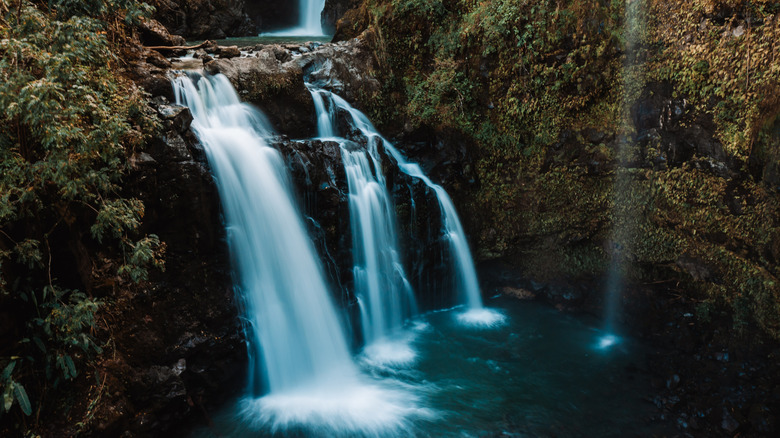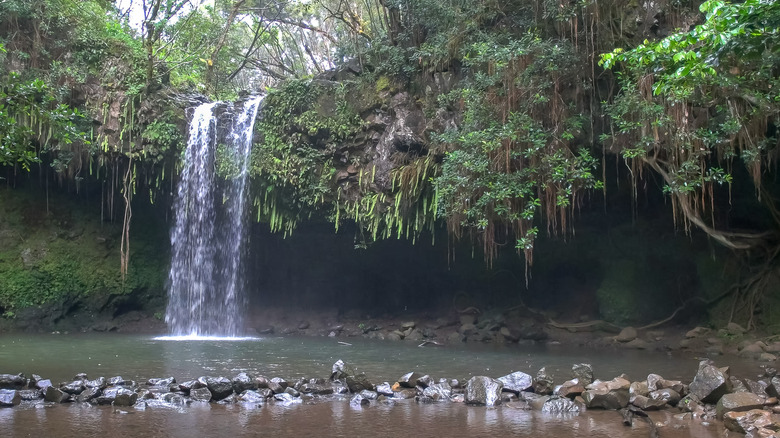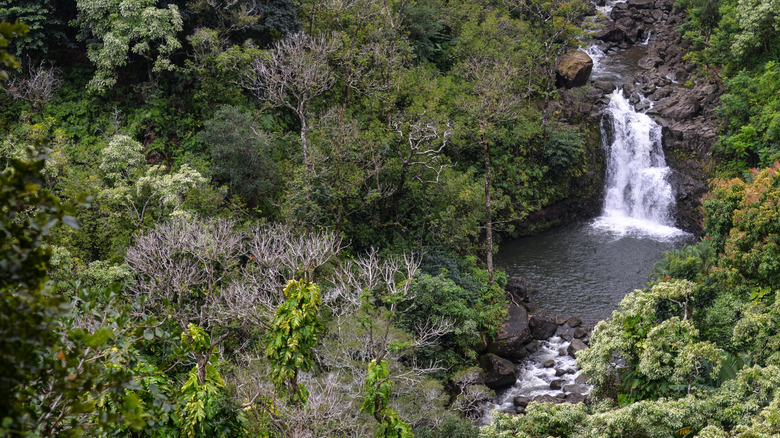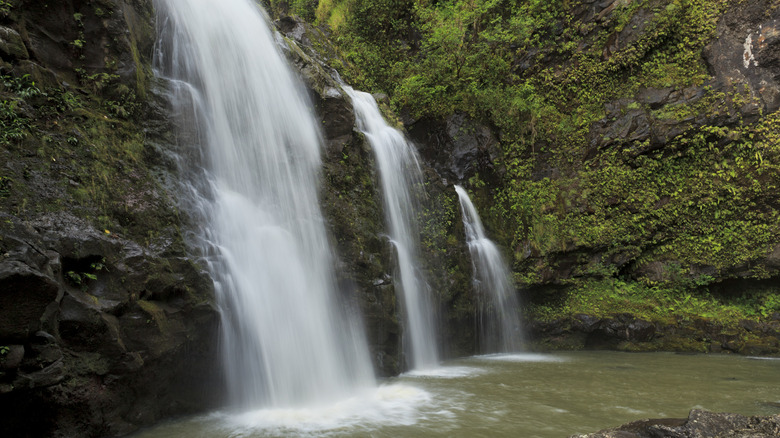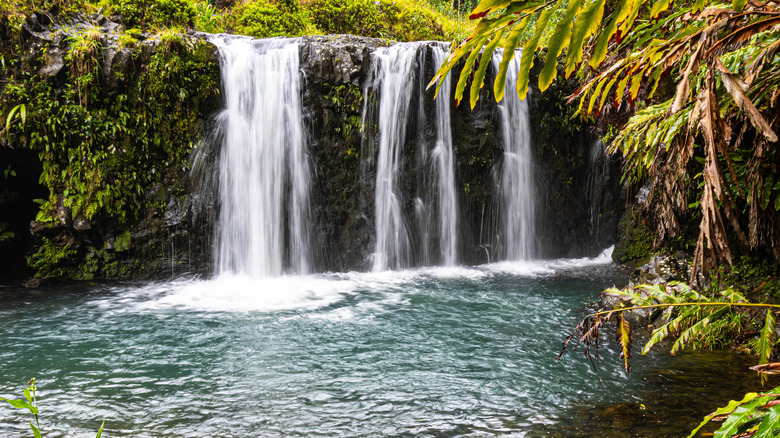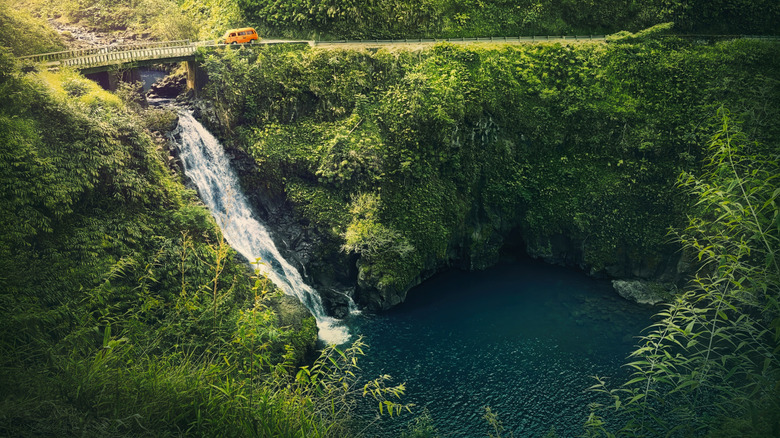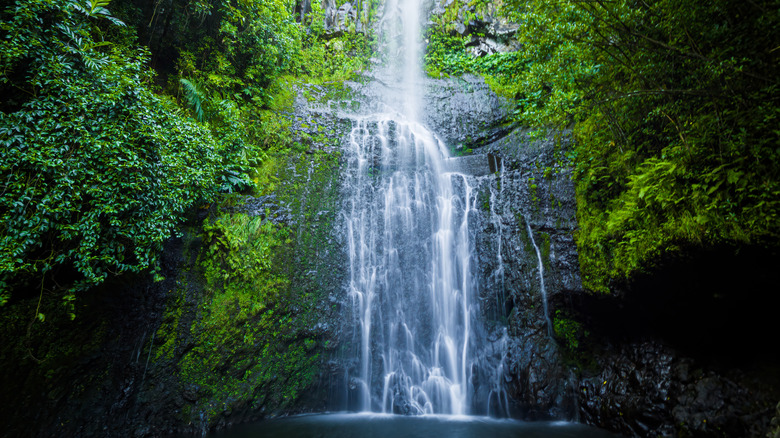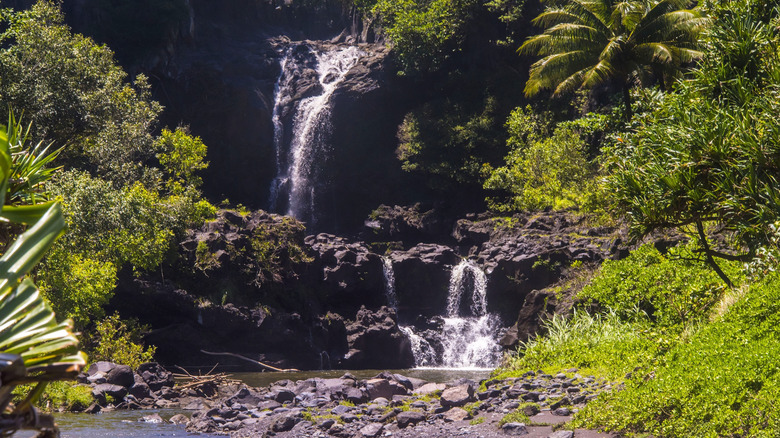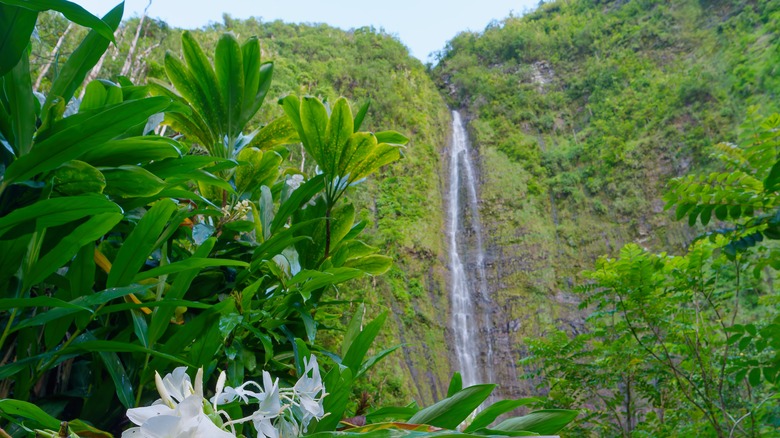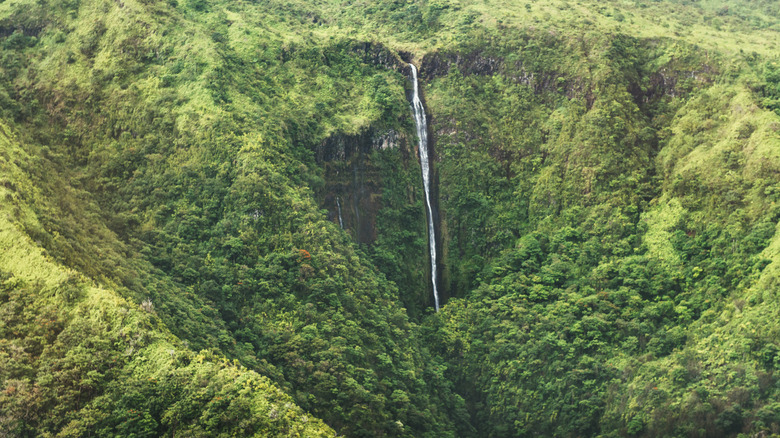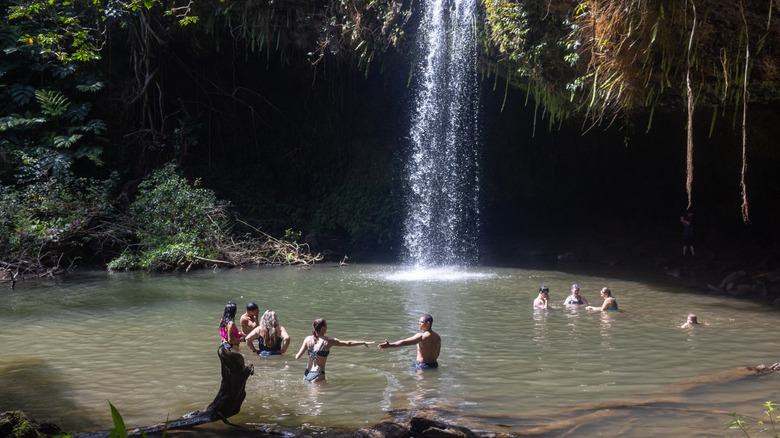Maui's Most Magical Waterfalls, According To Reviews
There's no shortage of waterfalls in Maui. Some are absolutely worth seeing, and some most definitely are not, but the range of falls is the point. In the dry season, you might come across narrow trickles that barely count. Turn another bend, and there's a full-on multi-tiered monster crashing down a cliff. Most people end up visiting one or two that are easily accessible and think they've done it. However, if you actually want to see what Maui has to offer, you'll need to put in a little bit of extra work. You can see many right off the road, while others will have you hiking through mud, slipping over rocks, and swatting mosquitoes while wondering if you've got your life choices wrong again.
We've taken to Tripadvisor and Google reviews to find the best-reviewed waterfalls in Maui. But whichever you decide on visiting, you'll likely need to brave the Hāna Highway. Most of the best are along this road, which winds from the hippie haven of Paia near the airport to the far side of Haleakalā. It's as rugged as it is rewarding, with lush jungle, wild, untouched coastline, and a spectacular cascade awaiting around what seems like every corner. It may be one of the best things you can do on Maui, but it can be slow, unpredictable, and not exactly forgiving. But if you're prepared, with the stunning cascades on offer, it's more than worth the effort.
Twin Falls
Twin Falls is the most popular waterfall site on Maui, going by the number of reviews on Google and Tripadvisor. It's the first major falls on the Hāna Highway and one of the most accessible. It's best to arrive early if you want to beat the crowds. The initial hike to the lower falls follows a well-maintained gravel road, and the waterfall itself is pleasant (if slightly underwhelming), with a nice swimming hole. The lower falls are often the end of the road for visitors, but there are actually three waterfalls along the trail — a second 20-foot cascade with a swimmable pool and a final one at the end.
The final cascade is named Caveman Falls, and while some tourists are put off by the "experienced hikers only" sign, the reality is that it will likely only prove tricky after bouts of rain. The entire hike there and back takes 1–2 hours to walk and covers a total distance of 1.5 miles. Challenges can include mud and deep streams, but when dry, these streams are shallow and easily crossed. Beyond the sign, the foliage gets thicker and more lush, and after around a half hour of walking, you'll catch the first sight of twin cascades dropping in front of a dark cave that gives Caveman Falls its name. Before arriving, you should note that on the first Saturday of every month, Twin Falls is open to Maui residents only. Additionally, there are strict parking rules that must be adhered to at all times to gain access to the site.
Haipua'ena and Puohokamoa Falls
The next significant site after Twin Falls is the Three Bears Falls, some 17.5 miles further along the highway. However, if you want to break the journey up, there are a couple of worthwhile stops for a refreshing dip. Haipua'ena Falls is a quick stop with a calm pool and a gentle cascade. It's a pleasant, uncrowded place for a short swim or a stretch of the legs. There is a second, larger fall upstream, but access isn't advised due to unsafe footing on the trail up.
Less than a mile further are the Puohokamoa Falls, which are actually a pair of cascades. The upper falls used to be a popular stop but are now fenced off on private land. However, you can still get a great view of them from the Garden of Eden, an arboretum with a paid entrance (turn off at mile marker 10.5) near one of Maui's "Jurassic Park" filming locations. One Tripadvisor reviewer describes the site as "beautifully maintained, peaceful, and full of stunning photo spots—including waterfalls, ocean views, and lush tropical plants." The lower falls are trickier to spot but visible from a roadside lookout.
Upper Waikani Falls
Upper Waikani Falls, aka Three Bears Falls, is one of the easiest stops along the Hāna Highway and ranks as one of the best among Google and Tripadvisor readers. This trio of waterfalls, named Papa Bear, Mama Bear, and Baby Bear, is just past Mile Marker 19. When the weather is dry, each stream is distinct and picture-perfect. But after the rains, they merge into one thunderous family and drop about 70 feet into a clear, rocky pool below. Most people view from the highway bridge, but the adventurous enjoy a more intimate experience at the base. However, getting there takes a bit of effort.
You'll need to scramble down a steep but manageable slope. The rocks are slick with moss, and the descent, while short (about 100 yards), is slippery enough to make shoes with grip an absolute necessity. Flip-flops are quite simply a dangerous choice. Additionally, once at the bottom, don't stand directly under the cascade, as debris falling from 70 feet above is a real issue. For those who make it down, you'll likely have the place to yourself. If you're one for a cold swim in a quiet pool, surrounded by red torch ginger and 15-foot ferns, making the trek down is well worth it. One impressed Tripadvisor reviewer took the time to write, "This was our favorite stop on the road to Hāna. A quick but tricky and slippery climb down [to] the bottom, and it was amazing!"
Pua'a Ka'a Falls
Around 4.5 miles in a southerly direction from Three Bears is Pua'a Ka'a Falls. While this stop may not offer the sublime views of many other waterfalls in Maui, it is a thoroughly pleasant setting and is ideal for a picnic while working your way down the Hāna Highway. The falls are part of the Pua'a Ka'a State Park, and the lower waterfall is just steps from the parking lot. There are clean bathrooms, decent parking due to the moderate number of visitors, and even a few cats to say hello to. It's a lovely area to stretch your legs, take a dip, or enjoy the shaded picnic tables. The waterfall itself is not a showstopper, but it is 15 to 20 feet tall and offers a cool dip, although the water flow can be on the light side if it hasn't rained. It's quite simply a peaceful, green pause in your day to catch a few rays, cool off, and enjoy nature.
If you are feeling a little more energetic, there's a second fall farther in. It's similar in size to the parking lot cascade but has a stronger, undiverted flow that feels wilder and more rewarding, especially after the rain. Take note that the trail to get there can be slippery and involves an awkward walk along a narrow embankment, which isn't for everyone, especially those with vertigo. However, for the undeterred, the payoff is a more natural cascade tucked deeper into the greenery. One Google reviewer was so pleased that he left a review telling us that it's an "awesome little spot to get out and relax, use the restroom, have a picnic, watch people jump off the top of the waterfall, and go swim!"
Hanawi Falls
If the size of the falls in Pua'a Ka'a State Park fails to impress, brace yourself for the two-tiered Hanawi Falls just a mile and a half further along the Hāna Highway. This waterfall pours, crashes, and fans out into a pair of plunging cascades that tumble 200 feet through the jungle like white ribbons. It's set in wild rainforest, and the water spills over forested rock into a pristine pool ringed by hala trees and dense groves of koa and white ginger. The scene is a living postcard, and thanks to the Hanawi Stream, the falls cascade year-round, even during drier spells. One Google reviewer said, "We stopped here on the road to Hāna and had to stop again on the way back because it's so beautiful."
However, if you're really chasing serious drama, come after the rains when the flow is at its most thunderous. The wetter season runs from November to March, and early mornings deliver the softest light and fewest visitors for the perfect time to take snaps. The narrow bridge that crosses the Hanawi Stream along the Hāna Highway is where you'll get the best views. There are a couple of tight pull-offs just before and after that give you just enough room to park, hop out, and take a quick photo. But for those itching to get closer, nearby nature trails wind briefly through the rainforest. Just beware, footing can be slick underneath, especially after the rains, and flash floods are a real danger in this part of Maui. That said, some visitors do make their way to the base for a cold dip. However, if you want to attempt the hike down, stick to the marked paths, bring solid shoes, and always check the forecast.
Makapipi Falls
Just 1 mile along the road from Hanawi Falls is Makapipi Falls, another stunning cascade that's highly praised on Google and Tripadvisor. It sits at mile marker 25, and to get a great view of it, you just need to pull over after the bridge and walk back a few steps along the roadside. However, parking is very limited, but finding a spot to briefly pull over isn't out of the realm of possibility. If you do manage it, don't forget your camera; you'll definitely want some snaps of this impressive waterfall dropping straight down into the tranquil sapphire-blue pool below.
You get the best view from the bridge. The drop is deep and dramatic, and the contrast of white water against the mossy rock and shadowed foliage makes for Instagram-worthy photos. However, watch your footing, don't lean over too hard, and be careful of oncoming traffic. The drop is sheer, the road is windy and narrow, and the cars may not slow down just because you're angling for the perfect shot.
To witness it in full flow, the waterfall is best seen during the November to March wet months. The drama does dial down in the drier months, and if there hasn't been any rain for a while, it may even be reduced to a trickle. One Google reviewer was enthusiastic but cautious with their words when they said, "Beautiful waterfall; can really only see it from the bridge or the road. Very steep cliffs, be careful! Worth a picture or two!!!"
Wailua Falls
After Makapipi Falls, you've covered the best-reviewed on Tripadvisor and Google on the Hāna Highway. You can now enjoy the seaside town of Hāna and everything "the heart of old Hawaii" has to offer travelers. However, there are more cascades to visit further south. Technically, you'll now be on Highway 31, but this stretch of road is still usually referred to as the Hāna Highway. The first significant waterfall you'll come to is Wailua Falls, some 7.5 miles south of Hāna. This site is very popular among Google reviewers, and Tripadvisor contributors agree. It's located just beyond mile marker 45 and is another easy-access cascade fully visible from the road. The main viewing area is next to the narrow highway bridge, where an elongated pullout serves as informal parking. However, the area can fill up quickly with tour groups and vendors, so you might want to time your arrival here for the early morning.
Framed by draping tropical foliage, Wailua Falls is one of the most photographed spots on the Hāna Highway. It plunges approximately 95 feet down a sheer jungle wall. But like many other Maui falls, the water flow depends on recent rainfall. It can thin out quickly during dry spells, especially late in summer. But in the wet season, it roars to life. A short, optional path leads down to the pool. It's a peaceful place for a quick dip or to get a different angle for photographs. The path can be slippery, particularly after rain, so step carefully.
Pools of 'Ohe'o (Seven Sacred Pools)
A few miles south of Wailua Falls, you'll find the Pools of 'Oheʻo, otherwise known by their tourist-trap nickname, the Seven Sacred Pools. This nickname is a marketing remnant from the 1900s, and it isn't even accurate, as you will find closer to 20 pools in the area. Whatever name you use, the moment you stand over that lush green ravine framed perfectly with verdant rainforest and volcanic rock, you'll be hooked. A stream of flowing and falling cascades feeds the Pools of 'Ohe'o, and they eventually spill out into the big blue ocean. This chain of dreamlike plunge pools is quite simply one of Maui's most dramatic natural scenes, which prompted one Google reviewer to say, "This series of waterfalls and pools is everything the guide books claim."
But if you're hoping for a swim, think again — swimming is currently off-limits due to safety risks. Flash floods and rockslides have kept the pools closed, and fatalities have occurred. Please, stick to the rules. Additionally, this area sees frequent rainfall, even in the dry season, which makes conditions unpredictable. In general, the safest place to view is from the paved overlook.
To access the site, there's a $30 per vehicle national park fee, which also covers the summit district, the upper region of Haleakalā National Park. Pay at the Kipahulu Visitor Center, where you'll also find a campground, parking lot, picnic tables, and restrooms. The pools themselves are reached by a short, flat trail less than half a mile long. However, things get busy pretty fast, especially around late morning. To beat the crowds, stay overnight in the campground or rise and shine early before traveling.
Waimoku and Makahiku Falls
For those exploring the Hāna Highway at length, Waimoku Falls is often the final stop. However, this one isn't as accessible as others; getting there requires a bit of a hike. But the rewards are apparent, as this waterfall is the best-reviewed on Google and Tripadvisor. The 4-mile Pipiwai Trail round trip begins at the Kipahulu Visitor Center, just over 10 miles south of Hāna. It's part of the Haleakalā National Park, and you'll need to pay a $30 entrance fee ($25 for motorcycles or $15 if you arrive on foot) and the trail takes around two to three hours for a moderately fit person to complete. Start early in the morning before the temperature gets too high and the gaggles of tour groups show up.
You'll cross wooden boardwalks and pass the stunning Makahiku Falls, a 200-foot horsetail waterfall that spills in a narrow ribbon down a steep, fern-lined cliff. You'll also pass a massive banyan tree and an atmospheric bamboo tunnel of light and shadow — a quiet, still place that feels strangely meditative. At the end, you reach Waimoku Falls — a 400-foot drop straight down a fern-covered cliff into a misty pool. The rock walls close in, the rainforest wraps around, and the whole thing feels remote and untouched. After the rain, extra streams appear and tumble down alongside it, turning a dramatic view into something even more unreal. However, a word of caution. Many visitors venture past the official trail end to reach the base, but rockfalls have occurred there that have resulted in fatalities, so the warning signs are not just for show. If you choose to go beyond the marked endpoint, stay alert, wear sturdy footwear, and avoid lingering anywhere near the cliff face.
Honokohau Falls
Waimoku Falls marks the last significant stop for waterfalls along the Hāna Highway. However, if you're still not satisfied, there is one more on the island of Maui you should visit if you can. Mind you, driving to this one is impossible. In fact, you can't even walk there. To get to the towering Honokohau Falls, you'll need to take a helicopter tour. This waterfall is the tallest on the island at an incredible 1,100 feet, and it was made famous after its memorable cameo in "Jurassic Park." You'll need to plan ahead, as demand for this tour is high, especially during peak season. Flights depart from Kahului Airport and soar above the island's most remote terrain, revealing dense rainforests, jagged cliffs, and hidden valleys as you sweep through the ravines and highlands.
Then, the falls reveal themselves, towering above and completely untouched. Honokohau plunges in two distinct stages, with the first drop dominating the scene before spilling into a second, shorter cascade below. It's so tall it seems to fall directly from the clouds, slicing down a fern-laced gorge deep in the West Maui Mountains. Locals argue it's even taller than the official figures, and from the air, you might just believe them. Beyond its cinematic fame and jaw-dropping size, the falls are also culturally significant. They are part of the Honokohau Stream, which once sustained Native Hawaiian taro farming in the valley below, and the area is still revered by the Kānaka Maoli today for its natural and cultural significance.
Methodology
We discovered all the waterfalls mentioned on Google and Tripadvisor and combined their scores and review numbers to get the top-rated. We discarded those that don't have, or have very low, review numbers, and put them in order of their appearances along the Hāna Highway. The last entry, the Honokohau Falls, is the only exception to the rules.
